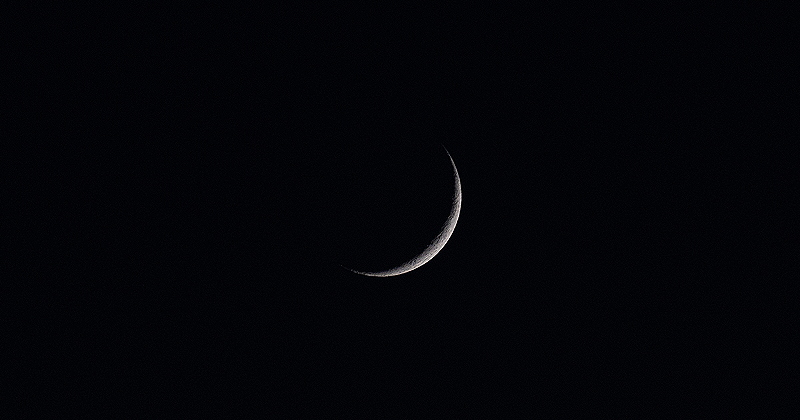DSLR 14mm Ultra Wide Angle Lens tests;
Moon/Mercury/Venus, Milky Way, NGC7217 Galaxy
Posted: 1 October 2019
I received a new Rokinon 14mm Ultra Wide Angle (UWA; rectilinear) f/2.8 manual lens on Monday, 30 September 2019. I purchased this lens specifically for sky photography. Being a manual focus lens it is necessary to set the lens for the right focus distance. My Nikon D850 DSLR provides a focus assist indicator when the object is in focus. For sky photography the lens must set to Infinity. I noticed that the lens actually has two Infinity markers:


The second one seems to be the correct setting for my D850 DSLR.
Here are some daytime comparison images at different focal lengths (f/2.8):
Rokinon 14mm (FOV 104° x 81°)

Tamron 24mm (FOV 74° x 53°)

Tamron 50mm (FOV 38° x 26°)

Since the lens is "rectilinear" the distortion as the lens is aimed upward or downward from horizon is minimal. For sky photography without a foreground this will not be noticeable and so this lens will be much preferred for sky photography vs my Rokinon 8mm fisheye lens. I did notice that the 14mm lens is a little "soft" at the left edge at f/2.8. The image is improved at f/4 and good at f/8. Of course, f/8 is more than I want to use for sky astrophotography.
|
Open: Monday, 30 September 2019, 1810 MST Temperature: 91°F |
Session: 1387 Conditions: Mostly clear |
Equipment Used:
12" f/8 LX600 w/StarLock
2" 24mm UWA eyepiece
SkyTracker Pro
Camera:
D850 DSLR
iPhone 8 Plus
1812 MST: sunset.
1816 MST: LX600 ON, StarLock OFF, High Precision OFF.
1818 MST: viewed the crescent Moon, 102X.
1834-1846 MST: viewed the western sky from the house front patio. Took some photos of the crescent Moon and the sky showing the Moon and the planets Mercury and Venus.
This handheld photo (cropped) was taken with the D850 DSLR (f/5.6, 1/640sec, ISO 1250, FL 300mm):

This photo (f/4.5, 1/30sec, ISO 1250, FL 90mm) shows the Moon and the planets. Venus is bright object in the lower righthand corner. Mercury is faint near the center just above the mountains. Click on the photo to see a larger version with labels.

Click or tap on image for larger version with labels
After returning to the observatory I took a quick look at the Moon, 102X. This is a handheld iPhone 8 Plus photo, afocal 102X:

1855 MST: I then set up the D850 DSLR with the Rokinon 14mm UWA lens on my iOptron SkyTracker Pro north of the observatory. The iPhone photo below shows the SkyTracker Pro, observatory, and the planet Jupiter at the top.

I did some initial sky astrophotography tests of the new lens using the Milky Way. There were some clouds in the southern (and eastern) sky. I did tests with the lens at f/2.8 and f/4. I determined that the second Infinity setting (lens not fully rotated to Infinity) was the best for my D850 DSLR. The edges were nicely focused using f/4. This is a f/4, 1 minute, ISO 3200, White Balance Auto, FL 14mm, tracked photo:

Click or tap on image for larger version
I am definitely going to enjoy using the Rokinon 14mm UWA lens for astrophotography.
1946 MST: returned to the observatory. Viewed M15 (globular cluster), 102X. Then viewed Saturn and 4 moons, 102X.
Next, I slewed the telescope to NGC7217 (galaxy) to check the seeing conditions and StarLock autoguiding. Autoguiding was acceptable, but some breezes had come up. Mounted the D850 DSLR at prime focus of the 12" telescope, focused on the star Altair, and locked the primary mirror.
2002 MST: High Precision ON. Slewed to NGC7217. 2005 MST: StarLock ON.
Took this image of NGC7217, StarLock autoguided, 5 minutes, ISO 6400, WB 4550K, cropped, for my Extragalactic Supernova Project.

2020 MST: StarLock OFF, High Precision OFF.
Due to thin clouds that were becoming more obvious I ended the imaging.
I viewed the galaxies NGC7217 and NGC7331, 102X.
I then spent several minutes just enjoying the view of the night sky from my dark sky site.
2047 MST: LX600 OFF.
|
Close: Monday, 30 September 2019, 2056 MST Temperature: 68°F |
Session Length: 2h 46m Conditions: Partly cloudy, breezy |
Comments are welcome using Email. Twitter users can use the button below to tweet this report to their followers. Thanks.
Cassiopeia Observatory Home Page
Copyright ©2019 Michael L. Weasner / mweasner@me.com
URL = http://www.weasner.com/co/Reports/2019/10/01/index.html
